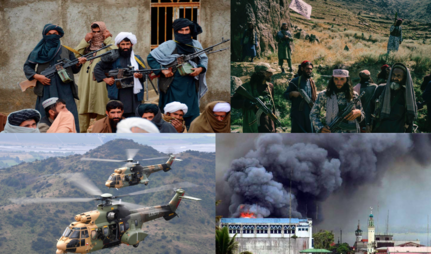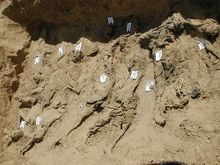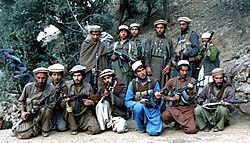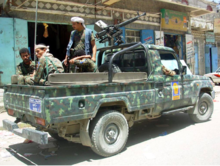Deltinian Insurgency
The Deltinian Insurgency (Creeperian Spanish: Ինսփրգենծիա Դելտինիանո; Deltinian: التمرد الدلتيني; transliterated: al-Tamarud al-Diltiniu),[note 4] also sometimes referred to as the Deltinian Conflict or the Southern Creeperian War, referred to by the Creeperian government as The Second Crusade (Լա'Սեգփնդա Ծրփզադա) and referred to by the Deltinian militias as The Jihad (الجهاد; al-Jihad), is an major ongoing asymmetric internal conflict and insurgency in southern Creeperopolis. The insurgency is primarily centered in the Creeperian department of San Juan, however, the conflict has also spilled over into the neighboring departments of Castilliano, Senvar, and Sonsatepan, as well as into the neighboring nation of Sequoyah into the Arapaho and Eastern Sequoyah provinces.
The insurgency is generally considered to have begun on 18 February 1978, when the Deltinian political and religious leader, Mullah Iftikhar al-Mutasim, was assassinated by the National Intelligence Directorate (DINA), leading to the spread of race riots across the department. Deltinians rose up, attacking Creeperans and Castillianans, which resulted in widespread attacks being directed at the Deltinians by pro-government militias and riot mobs. The Society of Deltinian Brothers, a self-defense militia group, was subsequently established by Muhammad al-Umar, as was the Holy Army of al-Mutasim by Usaama al-Khalid, to fight against the rioters and the Creeperian government, and on 6 October 1978, the two militias declared independence as the Emirate of Deltino.
The conflict has infamously become known for war crimes committed by both sides during the conflict, the high death toll of civilians, and notable terrorist actions committed against government and military targets, infrastructure, and civilians. The Terraconserva Council of Nations (TCN) has met several times in regard to the ongoing conflict and crisis in southern Creeperopolis throughout the conflict's history. As a direct result of the insurgency, hundreds of thousands to millions of people have been displaced with thousands more fleeing the country as refugees. Poverty rates have severely risen while access to healthcare and education have been severely limited by the conflict. Around 800,000 to 1,275,000 civilians have been killed since the start of the insurgency, and another 1,500,000 to 2,125,000 civilians have been wounded. Meanwhile, the combined military death toll of the fighting factions, relative to the civilian death toll, is only 190,000 to 240,000.
The war is primary a religious and ethnic-fueled conflict, with fighting occurring between the mostly Catholic Creeperans and the mostly Islamic Deltinians. The conflict is one of many wars which have occurred between the two religious and ethnic groups since 744 AD. The insurgency has been labeled as a "crusade against Islam" by several Creeperian politicians and military officers. Likewise, the insurgency has been described as a "jihad against Catholicism" and a "jihad against Creeperian oppression and imperialism" by Deltinian rebel leaders.
Contents
- 1 Background
- 2 Al-Mutasim's negotiation efforts
- 3 Beginning of the insurgency
- 4 1983 Nuevo San Juan attacks
- 5 Operation Miguel I
- 6 Mano Dura (1995–2005)
- 7 2006–07 Deltinian offensive
- 8 2007–09 Deltinian counteroffensive
- 9 Súper Mano Dura (2009–2019)
- 10 2019–20 Deltinian offensive
- 11 Casualties
- 12 Impact on Deltinian society
- 13 War crimes
- 14 Deltinian Genocide
- 15 Reactions
- 16 See also
- 17 Notes
- 18 References
- 19 Further reading
- 20 External links
Background
Creeperian–Deltinian ethnic and religious tensions
Part of a series on the |
|---|
| History of Creeperopolis |
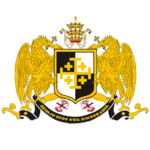 |
|
|
Since the arrival of Deltinians in Sur in 734 AD and their subsequent conquest of the Old Kingdom of Creeperopolis in 745 AD, ethnic and religious tensions between the two groups have been common throughout their shared history. The first major instances of overt ethnic and religious violence between the two groups occurred during the Creeperian Crusade between 1231 and 1345, where both groups massacred the other; Deltinians massacred Creeperans and Creeperian Catholics, and Creeperans massacred Deltinians and Deltinian Muslims. Tensions culminated in the massacre of Almadinat Almuqadasa on 13 June 1326 and the massacre of Shata' Albahr on 25 December 1345.
On 14 June 1326, Creeperian King Miguel I proclaimed the Decree of La'Victoria, which outlawed the practicing of Deltinian Islam within Creeperopolis' domains. Practicing the religion was made punishable by death, beginning the First Great Persecution of Deltinian Islam which lasted from 1326 until 1600, when the decree was nullified and rendered void by the First Parliament. During the nearly-three hundred year period of persecution, an estimated "millions to tens of millions" of Deltinian Muslims were killed. The largest instance of ethnic and religious violence between the two groups between 1600 and 1839 was the 1620 Abdan race riot, during which, a race riot against Deltinians and Muslims, killing Badri al-Morad, the first Deltinian member of the First Parliament, and 1,418 other Deltinian civilians.
On 4 May 1839, Creeperian Emperor Adolfo III proclaimed the Decree of San Salvador, again outlawing the practicing of Deltinian Islam in Creeperopolis. Between 800,000 and 1.2 million Deltinians and Deltinian Muslims were killed between 1839 and 1887 in the Second Great Persecution of Deltinian Islam. The persecution was ended on 31 December 1887 when the Second Parliament nullified it and rendered it void. Because of the second persecution and the role that several right-wing politicians had in its execution, the overwhelming majority of Deltinians and Deltinian Muslims aligned themselves politically with the left-wing People's Social Coalition, mostly voting for the Creeperian Socialist Party (PSC). Throughout the Second Parliamentary Era, the party had attempted on various occasions to reconcile Creeperian–Deltinian relations and to have those responsible for the second persecution brought to justice, increasing their popularity with the people.
In 1921, the far-right Creeperian Pro-Fatherland Front (FPPC) was established by Carlos Hernández Videla, and throughout its "reign of terror" during the Second Parliamentary Era, the group utilized its paramilitary Camisas Negras to intimidate its political opponents. The group also, however, also targeted, attacked, and killed Deltinians and Deltinian Muslims as a part of their ultranationalistic ideological beliefs. The attacks increased Deltinian and Deltinian Muslim support for the political-left, however, they opposed the far-left and their anti-theist policies, particularly the Creeperian Social Communist Party and their Atheist Red Army.
Civil-war era atrocities

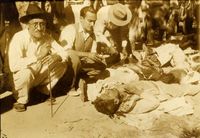
Upon the outbreak of the Creeperian Civil War, the Deltinians and Deltinian Muslims were unable to align themselves with either side of the war, as on one side was the far-right, fundamentalist Catholic, and fascistic Catholic Imperial Restoration Council, and on the other side, was the far-left, fundamentalist Atheist, and communistic National Council for Peace and Order. On 7 May 1937, hundreds of thousands of Deltinians, led by Muammar al-Koroma, a Deltinian imam, revolted against the authority of the National Council after the Huetapán massacre, in which the National Council executed 24 Deltinian imams for practicing Deltinian Islam. The rebellion, which occurred in Abdan, Helam, and Jakiz, historically referred to as the "Deltinian departments," was crushed by the National Council by 17 May 1937. General Pascual Espinar Casaus reported that his soldiers killed 3,139 "rebelling Deltinian guerrillas," while Deltinians claimed that the National Council systemically massacred up to 328,000 Deltinians, mostly civilians.
Modern historians believe that the death toll was somewhere around the 50,000 to 100,000 range, however, the figure of 328,000 is still the most commonly spread figure due to both anti-communist and anti-islamic sentiment in Creeperopolis. After the suppression of the rebellion, Deltinian opposition to the National Council increased, however, the continued to oppose the Imperial Council as well. Many Deltinians came under attack from both the Camisas Negras and the Atheist Red Army in the aftermath of the rebellion, and news of the high death toll of the rebellion and massacre spread across Creeperopolis.
On 13 June 1944, the Militarist Nationalist Front (FRENAMI) paramilitary death squad, led by Adolfo Rivera López, committed the Denshire massacre in the city of Denshire. The massacre killed 25,000 people, most of whom were religious or ethnic Deltinians, and notably, the Militarist Nationalist Front executed the city's Mayor, José Núñez Barceló, for attempting to shelter Deltinians within the mayoral palace. The massacre was the largest committed by the Imperial Council against Deltinians during the civil war, and as such, the Creeperian government denies the existence of the massacre
Deportations of Deltinians
| This article is part of a series on |
| Anti-Deltinian sentiment |
|---|
 |
On 28 December 1949, Emperor Romero II, with pressure from former members of the Creeperian Pro-Fatherland Front and Catholic Royalist Party (PRC), issued the Proclamation of Deltinian Deportation which ordered the immediate deportation of all ethnic and religious Deltinians to the newly established department of San Juan in the southernmost part of Creeperopolis in territory from the recently annexed Kingdom of Castilliano. The deportation order began to be enforced the following day and the Creeperian Army and Creeperian Imperial Guard began forcibly deporting Deltinians to San Juan.
Most Deltinians in Creeperopolis at the time lived in the so-called "Deltinian departments" of Abdan, Helam, and Jakiz, which were the three departments that encompassed the territories of the former so-called Deltinian rump states – the emirates of Abdan, Helam, and Jakiz – which formed after the fall of the Caliphate of Deltino in 1326. Other notable minority groups of Deltinians living in San Luís, Senvar, and Zapatista were also deported, most of whom were descendants of Deltinians who lived in the short-lived Aljanub Caliphate of 1326 to 1331.
Violence against Deltinians was commonly committed by the Creeperian Army and Creeperian Imperial Guard, as Minister of Defense Alfonso Cabañeras Moreno stated that no one would be prosecuted or punished for any crimes committed against Deltinians during the process of the deportations. By the end of the first year of the deportations, around 30,000 Deltinians were deported and an estimated 21,000 more were killed. The deportations continued until 26 February 1978 when the Creeperian government ceased the deportations.
By the time the deportations ended, an estimated 2.4 million Deltinians being forcibly relocated during the deportations, meanwhile, an estimated 2.1 million Deltinians, or just under 44.68 percent of the 1949 population of 4.7 million, were killed, either through starvation, neglect, exposure, or murder, and a further 150,000 remain missing. The remaining 200,000 Deltinians who were not deported by February 1978 were later deported overtime throughout the 1980s and 1990s. By the 2010s, as little as 25,000 Deltinians remained in the historically Deltinian parts of Creeperopolis.
1968 race riots
On 14 January 1968, a Creeperian woman, Anastasia Felicia Guzmán y Rodríguez, was raped and murdered in Nuevo San Juan, the capital city of the department of San Juan. Her rape and murder was blamed on a Deltinian man, Ahmed al-Gabur. He was abducted by a mob of Creeperans, beaten, and lynched in the city center. For the next two months, mobs of Creeperans began indiscriminately killing Deltinians. The race riots of 1968 were stopped by the Creeperian Army on 19 April 1968 when the Army occupied the city. During the riots, an estimated 400 Deltinians were killed.
Al-Mutasim's negotiation efforts

Beginning in the mid-1960s, Mullah Iftikhar al-Mutasim, a Deltinian religious scholar and Islamic leader, began efforts to attempt to negotiate with the Creeperian government to improve the situation of the Deltinian people. Al-Mutasim was native to Jakiz, but was deported to San Juan in 1950 during the deportations, where he attained the title of mullah. Al-Mutasim became a prominent Deltinian leader, and using his influential position within the Deltinian community in San Juan, he attempted to negotiate with the Creeperian government for a variety of things.
Al-Mutasim was very passionate about convincing the Creeperian government to allow the Deltinians to return to Abdan, Helam, and Jakiz and to end the deportations to San Juan. He stated that Deltinians were dying at alarming rates due to the forced relocation to San Juan and that it would be beneficial to both the Deltinians and the Creeperian state if the deportations ended and the Deltinians were allowed to return. Despite his efforts, the Creeperian government rejected his pleas, and Jesús Tafalla Mancebo, the captain general of San Juan, had al-Mutasim arrested in 1966 and 1971 on charges of spreading anti-government propaganda.
He also attempted to bring an end to anti-Deltinian violence and discriminatory policies, especially in the wake of the 1968 San Juan race riots. He also pushed for the Creeperian government to help improve the living situation of the Deltinians, as around 80 percent of the Deltinian population at the time lived in poverty and suffered from various preventable diseases. He pledged that he would not request autonomy or self-rule for the Deltinian people in exchange for the Creeperian government's support, however, the government continued to reject al-Mutasim's negotiation efforts and compromises.
Some of the most conservative Deltinian political leaders rejected al-Mutasim's efforts to reach an agreement with the Creeperian government, seeing his efforts as traitorous and giving legitimacy to the Creeperian government, which had oppressed and persecuted Deltinians for over 600 years up to that point. Most Deltinians, however, saw his efforts as necessary and justifiable, as many feared that initiating a war to liberate themselves would only lead to more suffering and persecution by the Creeperian government, and possibly ignite a government-sanctioned genocide of the Deltinians. As such, al-Mutasim gained popularity throughout the 1960s and 1970s and the de facto leader of the Deltinian people, and many who opposed him were forced to retire from public life, flee the department, or were even assassinated by mobs of al-Mutasim's supporters. Al-Mutasim denounced the attacks against his opponents within the Deltinian community, however, he did little to stop his supporters from committing said actions.
Beginning of the insurgency
1978 race riots

The departmental government of San Juan saw al-Mutasim's rising support within the Deltinian community as a potential threat to the department's stability and the Creeperian control of the region. In late-1977, Tafalla Mancebo approached Minister of Defense Emmanuel Cabañeras Videla with the proposition of assassinating al-Mutasim to eliminate the Deltinian leader and decentralize any future efforts to rebel against the Creeperian state. Cabañeras Videla accepted Tafalla Mancebo's proposition, and on 18 February 1978, the National Intelligence Directorate (DINA) assassinated al-Mutasim while he was presenting a sermon at a mosque El Rosario, San Juan, as DINA agents opened fire in the mosque. The DINA killed 8 worshipers and injured 11 more during the assassination.
After al-Mutasim was killed and the DINA agents who carried out the assassination fled the scene, the worshipers in the mosque began to march out into the streets to protest against the assassination, calling for the immediate removal of Tafalla Mancebo and the ending of anti-Deltinian discrimination. The protests rapidly grew in size as the news of al-Mutasim's assassination spread, and soon, riots began across the department of San Juan.
Deltinians began attacking Creeperans and Castillianans, seeing them as historical and current oppressors, and many remaining Deltinian leaders began calling for a total uprising against the Creeperian state and the San Juañero departmental government. Mullah Muhammad al-Umar, one of al-Mutasim's most well-known supporters, called for all Deltinians to rebel against the Creeperian state and to attack those who sought to continue the oppression of the Deltinian people. Hundreds to thousands of Creeperian and Castillianan civilians were killed within the weeks following the assassination.
With the situation in San Juan quickly falling out of control, the Creeperian Army mobilized soldiers in the department to crush the riots, end the protests, and pacify the department. Soldiers began opening fire at crowds of rioting and protesting Deltinians civilians, inflicting heavy casualties upon the unarmed Deltinian civilians. Eventually, some rioters infiltrated barracks and stole guns, arming themselves in preparation for an armed insurrection.
The first incursion between the Creeperian Army and armed Deltinian rebels occurred on 16 March 1978 in the city of Santo Tomás, where armed Deltinians attacked the army barracks in the city. Although the attack was repelled, it signified the beginning of a large-scale Deltinian uprising. News of the attack spread across the Deltinian community, helping further increase anti-Creeperian sentiment and the popular will to rebel against the Creeperans. Armed Deltinians captured El Rosario on 22 March 1978, and quickly after the city fell, the Creeperian army began attempting to recapture the city. The city was recaptured on 29 April 1978, which is the traditional date of the end of the 1978 race riots, however, by then, the Deltinian Insurgency had fully begun.
1978–82 Deltinian offensive
1978–1979
On 5 May 1978, al-Umar, who attempted to organize a rebellion against the Creeperian government during the race riots, proclaimed the establishment of the Society of Deltinian Brothers (JAD or SOHEDEL), a self-declared Deltinian self-defense militia. The group's stated intentions were to protect Deltinians from attacks and violence and to fight for the improvement of rights and living conditions for the Deltinian people. Tafalla Mancebo immediately denounced the group as a terrorist organization and declared that membership within the Society of Deltinian Brothers was illegal and punishable by death.
The next month, on 14 June 1978, Usaama al-Khalid, an associate of both al-Umar and al-Mutasim, declared the establishment of the Holy Army of al-Mutasim (JMM or SEM) which had the same stated intentions of the Society of Deltinian Brothers. The group was named after al-Mutasim, and al-Khalid declared that his murder would be avenged and that Tafalla Mancebo himself would be assassinated in retaliation. As with the Society of Deltinian brothers, Tafalla Mancebo declared the group to be illegal and membership was punishable by death.
On 29 June 1978, al-Umar and al-Khalid issued a joint message to the inhabitants of San Juan, declaring war against the Creeperian state and calling upon all Deltinians to arm themselves and rise up against the Creeperian government. They called for all adult Deltinian men over the age of sixteen to join the Society of Deltinian Brothers and the Holy Army of al-Mutasim and to capture towns and villages across the department. Throughout July, August, and September 1978, thousands of Deltinian men joined the two militias and armed themselves with weapons stolen from army barracks and smuggled out of the department of Senvar from hidden caches of weapons which were left over from the Third Senvarian Insurgency. By late-September 1978, the Deltinians had captured 7 major cities and 58 towns and villages. La'Alta, the sixth largest city in the department, was captured by the Society of Deltinian Brothers on 1 October 1978 from Creeperian forces.
On 6 October 1978, al-Umar declared in La'Alta the establishment of the Emirate of Deltino, formally the Great Emirate of the Independent Deltinian State (Deltinian: الإمارة الكبرى للدولة الدلتينية المستقلة), as an independent Deltinian state from Creeperopolis, adopting the black banner of the Deltinian people as its national flag. The emirate claimed the entire department of San Juan, and indicated future plans of reconquering the departments of Abdan, Helam, and Jakiz, and the eventual reestablishment of Almadinat Almuqadasa. In the declaration, al-Umar stated:
The Creeperian regime has murdered millions of our Deltinian brothers over the past millennium. They destroyed Almadinat Almuqadasa, the city demanded for by the Holy Prophet to Abdul Humaidaan, and they built a heretical city on top of our holy city. They condemned our way of life and the truth, and instituted heresy as the national religion of their illegitimate state. They crushed our communities and evicted us from our homes, forcing us away from out homeland. Today, the Great Emirate will arise and reconquer our lost lands. Abdan will be reconquered. Helam will be reconquered. Jakiz will be reconquered. The heretical city will be destroyed, and Almadinat Almuqadasa will be restored to its former glory, and the great caliphate will one day be reestablished where our people will be free from oppression. San Salvador will suffer the same fate our holy city once did, and it will be razed to the ground and its inhabitants eradicated. Arise Deltinians; join the Jihad for liberty; fight like Sulayman once did, for al-Mutasim will be avenged.
— Mullah Muhammad al-Umar, 6 October 1978
After independence was declared, al-Umar ordered the execution of all captured Creeperian soldiers and politicians for their actions in suppressing Deltinian liberties. An estimated 1,500 soldiers and politicians were executed by the Emirate of Deltino in 1978. Additionally, many Creeperian and Castillianan civilians were killed, either through formal executions or in summary executions and mass shootings, in show trials on charges murdering Deltinians during the race riots. Between 1,000 and 1,500 civilians were executed in 1978 through these show trials. The executions of soldiers, politicians, and civilians was nearly universally condemned by the international community as a war crime, and several foreign nations in the succeeding years would go on to label both the Society of Deltinian Brothers and the Holy Army of al-Mutasim as terrorist organizations. Consequently, the Emirate of Deltino has never received foreign recognition of sovereignty.

Creeperopolis formally recognized both the Society of Deltinian Brothers and the Holy Army of al-Mutasim as terrorist organizations on 10 October 1978, after the Cortes Generales voted unanimously to declare both groups as such. The following day, the Ministry of Internal Affairs declared that both groups were barred from any legal protections or constitutional rights, and the Ministry of Law Enforcement made membership in either group illegal, with a minimum penalty of life imprisonment and a maximum penalty of death for committing the offense. Five days later, the Ministry of Labor formally allowed companies and businesses to unconditionally terminate Deltinians from employment if they are suspected to have connects to either group. On 19 October 1978, the National Intelligence Directorate announced the formation of the Anti-Terrorist Brigade (BAT), a military police and anti-terrorist task force specialized to combat acts of terrorism within Creeperopolis, and that the unit would focus most of its efforts on combating the actions of the Society of Deltinian Brothers and the Holy Army of al-Mutasim.
Between October 1978 and January 1979, the Anti-Terrorist Brigade arrested around 8,000 Deltinian civilians, suspected of aiding the rebels or being rebel soldiers themselves, in the Cruzadore Rey Alfonso I National Stadium in Nuevo San Juan. There, DINA agents tortured those they arrested to extract confessions out of them, and some reports alleged that false confessions were also sought out. Of the 8,000 arrested, only 832 were released, and an additional 1,203 were executed for assisting the two militias. The remaining approximately 6,000 have disappeared, and are believed to have been executed or sent to one of Creeperopolis' forced labor camps. Additionally, the DINA carried out several assassinations of prominent Deltinian military commanders and political leaders. Imams across the departed were also targeted by the DINA. Mosques were demolished, as they were seen to be safe houses for Deltinian forces, and laws were instituted which restricted the ability for Deltinians to worship in public.
On 22 November 1978, Sulayman al-Mutasim, the son of the assassinated religious scholar, was himself assassinated in Dishna by members of the Society of Deltinian Brothers who feared that he would challenge al-Umar to the position of emir. The assassination was condemned by al-Umar, describing al-Mutasim's assassins as traitors and "just like the Creeperans", and he had the six assassins put to death on 4 December 1978 after two days of torture. The assassination, together with the DINA's arresting of thousands of Deltinians, contributed to the offensive slowing down throughout 1979.
1980–1982
In October 1980, the Militarist Front for National Liberation (FMLN), a far-left Castillianan separatist group involved in the Castillianan Insurgency, declared its support for the Deltinian armed groups, arguing that both were fighting for a common cause against Creeperian tyranny. From October 1980 to July 1981, both groups mutually agreed to a non-aggression pact and both entities formally recognized each others' independence. On 6 July 1981, however, a group of 15 armed FMLN rebels were attacked by armed Deltinian rebels near La'Rosada. The Castillianans were captured and executed for allegedly encroaching on Deltinian territory. FMLN leadership was outraged, however, Deltinian leaders subsequently justified the massacre, stating that had they been Muslims, then the atrocity would have been unjustified. As a result of the incident, the FMLN withdrew recognition of the Emirate of Deltino and declared war on the Deltinian rebels. After the massacre, the FMLN formed the 6 July Front Against Oppression (6J–FCO) to be the group's branch which was dedicated to fighting the Deltinian militias, while the main group focused its efforts on anti-government activities.
Operation Alfonso I
1983 Nuevo San Juan attacks
Operation Miguel I
Al-Manah massacre
1985–1995 Deltinian counterattacks
Mano Dura (1995–2005)
2006–07 Deltinian offensive

2007–09 Deltinian counteroffensive
Súper Mano Dura (2009–2019)
2019–20 Deltinian offensive
Massacres of Helwan and Dishna
Subsequent death squad massacres
Incursions in Sequoyah
Third Battle of Nuevo San Juan
Casualties
Military casualties
Civilian casualties
Impact on Deltinian society
Refugees
Drug trade
Education and healthcare
Poverty
War crimes
Deltinian militias and rebel groups
Creeperian government and military
Creeperian foreign allies
Death squads and vigilante militias
Deltinian Genocide
Reactions
Domestic reactions
Government
Military
Other
International reactions
Governments
International organizations
International recognition of the Emirate of Deltino
Designation of groups as terrorist organizations
The Society of Deltinian Brothers and the Holy Army of al-Mutasim has been designated as terrorist organizations by various for many of their actions and atrocities committed over the course of the insurgency. Such atrocities include mass murder, mass rape, looting and pillaging, attacking civilian targets, and kidnapping civilians for ransom. The groups have also reportedly been involved in arms, drug, and human trafficking operations as a means to fund their terrorist operations.
The following nations have listed the Society of Deltinian Brothers and the Holy Army of al-Mutasim as terrorist organizations:
| Designated as a terrorist organization | Not designated as a terrorist organization | Designation unknown |
| Year designated indicated if applicable | ||
|
|
See also
Notes
- ↑ Morova never officially confirmed nor denied supporting the Emirate of Deltino after the letter was intercepted by the Creeperian Army.
- ↑ The Creeperian government denies supporting or being supported by the Anti-Deltinian Armed Forces of Liberation – War of Elimination (FALANGE), the Creeperian Catholic Protection Army (ECCP), the Militarist Nationalist Front (FRENAMI), the Movement of Organized Nationalist Action (MANO), the Militarist Front for National Liberation (FMLN), the 6 July Front Against Oppression (FCO–6J), and the various criminal gangs engaged in combat against the Deltinian militias.
- ↑ Some scholars place the start of the Deltinian Insurgency at the declaration of independence of the Emirate of Deltino on 6 October 1978, rather than the assassination of Iftikhar al-Mutasim and the subsequent 1978 San Juan race riots on 18 February 1978. This date would make the conflict have lasted 45 years, 6 months, 1 week and 5 days. Other scholars place the date at the foundation of the Society of Deltinian Brothers on 5 May 1978, which would make the conflict have lasted 45 years, 11 months, 1 week and 6 days. Other scholars place the start of the conflict on 29 June 1978, when the 1978–82 Deltinian offensive was declared by Muhammad al-Umar and Usaama al-Khalid, which would make the conflict have lasted 45 years, 9 months, 2 weeks and 6 days.
- ↑ Creeperian Spanish (Iberic): Insurgencia Deltiniano; Creeperian Spanish pronunciation: [in.suɾˈxen.sʝa del.ti.niˈa.no]; Deltinian pronunciation: [al.taːˈma.ruːd alˈdˤiːɫ.tiː.niː.uː].
References
Citations
- ↑ Franco Rodríguez, Carlos (11 January 2020). "Gaceta Creeperiano – Letra de Moroba Encontrado en Comandante Deltiniano Durante'l Conflicto Deltiniano" [Gaceta Creeperiano – Letter from Morova Found on Deltinian Commander During the Deltinian Conflict]. gacetacreeperiano.org.cr (in Creeperian Spanish). San Salvador, San Salvador, Creeperopolis: Gaceta Creeperiano. p. 1. Retrieved 3 August 2021.CS1 maint: unrecognized language (link)
Further reading
External links

|
LCN Wiki has media related to the Deltinian Insurgency. |
- Deltinian Insurgency (IIWiki; 29 February 2020)
- Articles containing Spanish-language text
- CS1 maint: unrecognized language
- Articles with short description
- Use dmy dates from August 2021
- Use Jackian from June 2022
- Articles with invalid date parameter in template
- All LCNWiki articles written in Jackian
- Articles containing Arabic-language text
- Pages with broken file links
- Creeperopolis
- Creeperopolis RP
- Creeperopolis Terraconserva
- Terraconserva
- Wars
- Creeperian Conflicts
- Deltino
- Deltinian Insurgency
- Wars involving Creeperopolis
